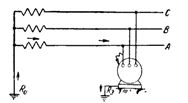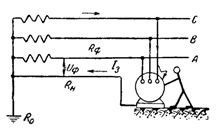Protective earthing in electrical installations
Zeroing is called the electrical connection of metal non-conductive parts of electrical installations with the grounded neutral of the secondary winding of a three-phase step-down transformer or generator, with the grounded output of a single-phase current source, with the grounded midpoint in DC networks.
The principle of operation of the reset is based on the occurrence of a short circuit during a phase breakdown of the non-current part of the device or device, which leads to the operation of the protection system (circuit breaker or blown fuses).
Zeroing is the main measure of protection against indirect contact in electrical installations up to 1 kV with a neutral earthed network. Since the neutral is grounded, grounding can be considered a specific type of grounding.
A neutral protective wire is called a wire connecting the neutralized parts (cases, structures, housings, etc.) with the grounded neutral of the power source (transformer, generator). See here for more details: Protective conductors in electrical installations (PE conductors).
In 380/220 V networks in accordance with PUE requirements grounding of neutrals (zero points) of transformers or generators is applied.
Consider first a 380 V network with a grounded neutral. Such a network is shown in Fig. 1.
If a person touches a conductor of this network, then under the influence of the phase voltage, a fault circuit is formed, which closes through the human body, shoes, floor, ground, neutral ground (see arrows). The same circuit is formed if a person touches the casing with damaged insulation. However, it is impossible to simply ground the housing of the electrical receiver.

Rice. 1. Touching a wire in a network with a grounded neutral

Rice. 2. Grounding of the electrical receiver in a network with a grounded neutral
To understand this, let us assume that such grounding is nevertheless performed (Fig. 2) and the installation is short-circuited to the motor housing. The short-circuit current will flow through two grounding switches — an electrical receiver Rc and a neutral Rо (see arrows).
From Ohm's Law the phase voltage of the network Uf will be distributed between the grounding electrodes Rz and Ro in proportion to their values, i.e. the greater the resistance of the grounding electrode, the greater the voltage drop in it.
If, for example, the resistance Ro = 1 ohm, Rz = 4 ohms and Uf = 220 V, then the voltage drop will be distributed as follows: at the resistance Rz we will have 176 V, and at the resistance Ro we will have = 44 V.
This creates a dangerous voltage between the motor housing and ground. A person touching the cabinet could get an electric shock.If there is an inverse ratio of resistances, that is, Ro will be greater than Rz, a dangerous voltage may arise between the earth and the frames of the equipment installed near the transformer and having a common ground with the neutral.
Rice. 3… Resetting the electrical receiver in a network with a grounded neutral
For this reason, in installations with a grounded neutral with a voltage of 380/220 V, a different type of grounding system is used: all metal housings and structures are electrically connected to the grounded neutral of the transformer through the neutral wire of the network or a special neutral wire (Fig. 3). Therefore, any short circuit to the housing becomes a short circuit, and the emergency section is turned off by a fuse or circuit breaker. Such a grounding system is called disappearing.
In this way, safety grounding is achieved by disconnecting the mains section in which a short circuit has occurred to the housing.
The protective effect of earthing consists in automatically disconnecting the part of the circuit with damaged insulation and at the same time in reducing the potential of the housing for the time from the moment of short circuit to the moment of disconnection. After a person touches the body of an electrical receiver that is not turned off for some reason, a current branch will appear in the circuit through the human body.
In addition, if an RCD is installed in this line, it also works, but not from a large current, but because the current in the phase wire becomes unequal to the current in the neutral working wire, since most of the current takes place in a protective ground circuit past the RCD.If both an RCD and a circuit breaker are installed on this line, then either or both will operate, depending on the speed and magnitude of the fault current.
Just as not all grounding provides safety, not all groundings are suitable for providing safety. The reset must be done so that the short-circuit current in the emergency section reaches a value sufficient to melt the fuse of the nearest fuse or shut down the machine. For this, the short circuit resistance must be low enough.
If tripping does not occur, the fault current will flow through the circuit for a long time and a voltage with respect to ground will occur not only on the fault case, but also on all reset cases (since they are electrically connected). This voltage is equal to the magnitude of the product of the fault current by the resistance of the neutral wire of the network or the neutral wire and can be significant in magnitude and therefore dangerous, especially in places where there is no potential equalization. To prevent such a hazard, it is necessary to carefully follow the PUE Requirements for the grounding device.
The protective action of neutralization is provided by the reliable operation of the overcurrent current to quickly disconnect the network section with damaged insulation. From PUE the time for automatic shutdown of the damaged line for the 220 / 380V network should not exceed 0.4 s.
For this, it is necessary that the short-circuit current in the phase-zero circuit meets the condition ITo > k az nom, where k is the reliability factor, Inom — nominal current from the setting of the disconnecting device (fuse, automatic physical switch).
The reliability coefficient k according to PUE must be at least: 3 — for fuses or switches with thermal release (thermo-relay) for normal rooms and 4 — 6 — for explosive areas, 1.4 — for automatic switches with electromagnetic release in all rooms .
The spread resistance of the neutral earthing device Ro (working earth) must be no more than 2, 4 and 8 ohms respectively at nominal voltage 660, 380 and 220 V of three-phase electrical installations.

